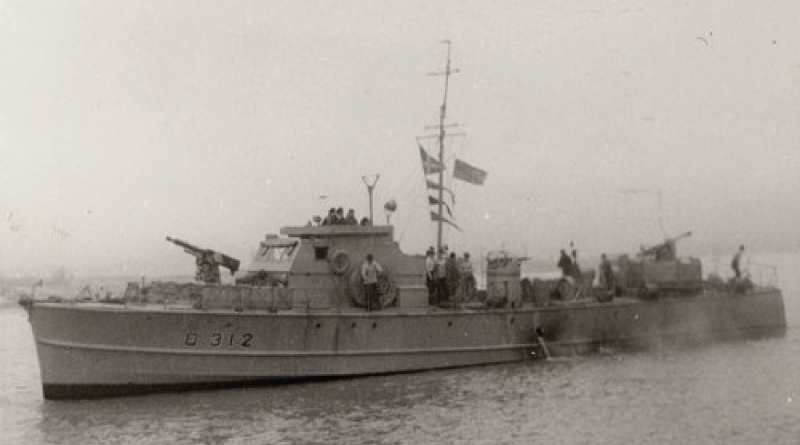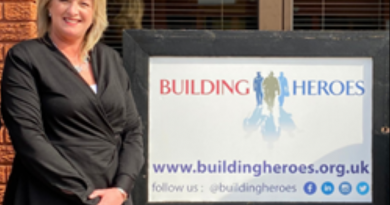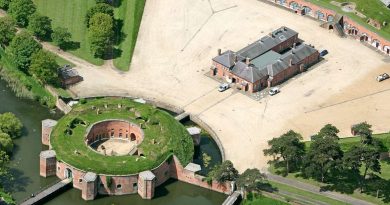COPP mission remembered on 80th anniversary
New Year’s Eve marked the 80th anniversary of a crucial mission carried out by the Combined Operations Pilotage Parties (COPP) in 1943; which saw two commandos become the first British troops to set foot on the Normandy beaches after sailing from Gosport.
They were stalking the sands in a vital reconnaissance mission a full six months before hundreds of thousands of Allied soldiers swept ashore on D-Day, as the battle to defeat the Nazis intensified in the summer of 1944.
Major Logan Scott-Bowden and Sgt Bruce Ogden Smith – who had taken part in a dummy run on Norfolk’s Brancaster Beach just nine days earlier – left HMS Hornet, in Haslar Creek, on the evening of December 31, 1943.
Scientists advising Combined Operations in Whitehall were very concerned that large dark patches showing on aerial photos of what was earmarked as Gold Beach, could be in fact a peat bog. The danger it posed if not checked was that Allied tanks, troops and heavy guns could be bogged down getting ashore and left as sitting ducks for Germans defending the beaches.
A plan to send the two commandos to France in a newly-built miniature submarine from HMS Dolphin was vetoed at the 11th hour.
The danger of revealing the invasion plan – when UK’s military intelligence chiefs and top secret agents were trying to convince any listening German ears that the intended target would be Calais – was considered too great the Commander-in-Chief at Portsmouth.
So instead, because of fears X-20 could not operate safely within the tidal range on the planned recce date, they were towed across the Channel in two even smaller landing craft than the one used in Norfolk – LCP (L) 290 and 292 – by three of Hornet’s Motor Gun Boats lead by MGB 312 captained by Lt Commander Alfred “Bobby” Nye, carrying the COPPIsts, while MGB 316 and 317 towed the landing craft.
Aboard LCP (L) 290 were the two swimmers and Lieutenant Commander Nigel Willmott, who commanded COPP (Combined Operations Pilotage Parties) from their top secret base on Hayling Island.
Accompanying them was signals officer Lt Peter Wild, who was part of COPP 6 – then based at Warsash’s HMS Tormentor, carrying out specialist hydrographical survey work connected with the Mulberry Harbour plans.
Lt Geoffrey Galwey – the officer who had set up COPP’s depot at Hayling Island Sailing Club, less than a year earlier, was the senior officer in the back-up craft.
The brave commandos spent four hours ashore in the early hours of New Year’s Eve 80 years ago – having been carried by the current nearly three-quarters of a mile east of their target.
Just as they had at Brancaster, they marked out the beach using the same inverted W pattern taking core samples with special augers, and recording their positions on special underwater writing tablets strapped to the forearm.
They made their way as far as the sea wall and checking the beach’s defences, dodging the bright beam of the Ver-sur-Mer lighthouse sweeping the sands – the COPPists later complained they had not been warned about the lights.
They were looking for gun emplacements, and exit routes wide enough for tanks and artillery units to punch their way inland.
Scott-Bowden wrote during the 50th anniversary of D-Day in 1994: “We made our way west, coming across a useful concrete ramp blocked at the top by heavy steel obstacles, known as ‘hedgehogs’, with extensive standard German wire entanglements on either side.”
“We risked walking as there was three-quarters of a mile to go before reaching the suspect area, but soon we were into an area traversed by the beam and had to flatten ourselves every minute or so. We then noticed that our craft, though well out (to sea), were being exposed by the beam as it swept by.
However, the weather was worsening and heavy slanting rain was beginning to diminish visibility. Feeling more secure from sentries further away from the village, we reached our area and started the examination, taking samples according to the pattern required, leaving out one leg of our ‘W’ as we were already at the back of the beach.
“The one who took the sample loaded it into a tube in the other’s bandolier. We took 10 each. Then we found a quite large exposed patch of peat standing a foot or so above the sand which had stood out clearly on the air photographs. We examined the sand all round it, which was of substantial depth.”
Major Scott-Bowden also recalled: “The Germans were having a carousal in the village. We could hear them singing and shouting when we reached the shelter of the seawall, which screened us from the lighthouse beam at Ver-Sur-Mer.”
But even then their mission was far from over – they had to negotiate their way back to the rendezvous point, which involved another 400-yard swim in a rising sea.
In the mid 1990s Bowden-Smith spoke to Ian Trenowden – author of Stealthily by Night, the account of COPP’s incredible history operating from Europe to the Far East.
He said: “We went out into the surf festooned as we were with our personal gear, plus loaded bandoliers and started swimming. We were smartly flung back. The wind was still strengthening. We quickly tried again – rather harder with the same result.”
“The prospects did not look too good. Nothing could be abandoned for fear of compromising secrecy. We sat as far out in the surf as possible to work out the wave pattern, hoping to be able to time the best moment to go. The lighthouse beam helped in this. At the third attempt, timing it right, we made it through the surf and swam hard to be sure of not being swept back again.“
But even amid the incredibly tense and tiring mission, there was still time for some military gallows humour.
Sgt Ogden Smith – who along with his superior risked being shot as spies if captured – found time to call out happy New Year to Scott-Bowden as they swam back to the landing craft.
His superior – fearing he had fallen behind him and might be in trouble with cramp chastised him.
He urged him to swim hard or risk being swept back to shore, before adding: “And a Happy New Year to you too,” Bowden-Scott recalled – with a broad smile on his moustached face – in a video filmed before his death in 2014.
Scott-Bowden rose to the rank of Major General in a life-long and very distinguished Army career, spending his retirement living at Ewelme, in South Oxfordshire.
The COPP team eventually landed with their samples at Newhaven, on New Year’s Day, having suffered terrible sea sickness during the tow home as the winds rose to near gale force. The MGBs were forced to head for a port further east because of the strong winds and tide.
The sand samples were rushed back to the 21st Army Group responsible for co-ordinating the D-Day plans. Meanwhile, the men returned to Fort Blockhouse by lorry.
Galwey recalled that they were back in time to head out of dinner on New Year’s Day – at the Queen’s Hotel, in Southsea, a wartime favourite with officers in the city. The Whitehall scientists – who less than a fortnight earlier, had thought COPP’s reconnaissance methods could not succeed undetected – were delighted just hours later to discover there was no peat in the samples brought back.
Three weeks later the pair would return to the Normandy coast with Willmott aboard X-23, after being towed from the Solent to the edge of a German minefield, before negotiating the Calvados reef off the French coast.
They spent four days from January 17-21 – surveying the what would become the American’s Omaha and Utah beach sectors, between Vierville-sur-Mer and Colleville.
Indeed, Scott-Bowden and Ogden Smith would help guide the American assault ashore, as the sun rose on D-Day, less than six months later.
Further along the coast two COPP teams aboard X-20 and X-23 would shine beacon lights out to sea from before first light to guide the British and Canadian forces ashore on Sword and Juno.
Readers can explore the timeline of events through a special document, which can be downloaded by clicking on this link. A map of Gold Beach can be viewed via this link (copyright National Archives), whilst images of Scott-Bowden and Odgen Smith can further be seen by clicking their names in this paragraph.
PICTURED BY DUDLEY MILLS: Image of the MGB 312, which was used in this mission on December 31, 1943.



